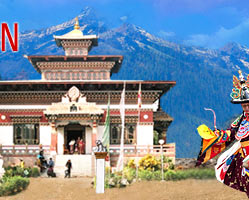To travel around Bhutan, you need route permits. The immigration office at Thimphu (near the gate of Trashi Chhoe Dzong) issues the permits. There are check posts in most of the districts situated east and north of Thimphu, where you will need to produce these documents before you can proceed. Buses are generally safe and well maintained but the roads across this mountainous country are generally rough and have lots of twists, turns, blind bends and steep inclines. Most of the tourists prefer to hire a mini-bus or a 4-wheeler via their tour operator to travel around Bhutan as local and inter-district bus services are not very comfortable and stop frequently.
But traveling in these public transportation buses will allow you to meet and interact with Bhutanese people first hand and be a part of real Bhutan. It is best to avoid traveling long distances during the monsoon season from June to August. The rock falls and landslides in this season are common in the mountainous terrain of Bhutan. If you must travel during monsoons, it is advisable to carry lots of bottled water and snacks along with your first-aid box because in an event of landslide, it may take some time for the road to clear out. The car takes two hours to take tourists, getting down at Paro Airport, to Thimphu. People who are entering Bhutan via road may catch bus to Siliguri from Calcutta, which takes about one and a half hours.
From Siliguri, they can take another bus that takes four to five hours to reach Joygaon. You can take a direct bus to Joygaon from Calcutta too. Joygaon in India is the twin city of Phuntsoling in Bhutan. In Phuntsoling, you will need to obtain travel permits and get your papers clear before the office closes at 5 pm. You can take another bus from Phuntsoling to Thimphu, which takes about eight hours and stops at multiple checkpoints, where your travel papers will have to be stamped. At Thmiphu, you can hire 6-seater taxis to reach anywhere or just walk across the city. You can also hire taxis on a share basis at Thimphu. Public transport between the towns of Bhutan is quite infrequent so you may have to hitchhike to get around too.
Bhutanese people do not recognize the ‘thumb in the air’ sign and you will have to flag down a passing vehicle to get it to stop and perhaps be picked up. Some drivers may pick up passengers to supplement their incomes though, most drivers do not require anything and are glad to help you out and have a company for the drive. Yet, it is customary to offer payment to the driver, comparable to the bus fare for the distance traveled, when getting out of the vehicle. If you are in the rural areas, you may need to hitchhike a lot and to keep a few small gifts for the drivers will be a good idea. The highest motorable road in the country is situated at an altitude of 4000 m above sea level and takes you across Thrumshingla Pass. Due to the difficult topography of the small nation, Bhutan has no railway service.




